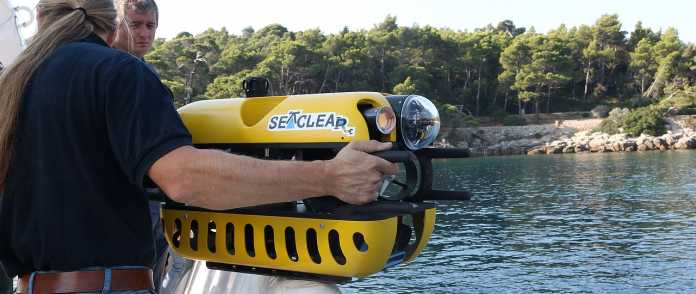The SeaClear project aims to remove plastic waste from the ocean floor using robots. Most of the non-rotting waste dumped in the oceans is now on the sea floor, the amount of which is estimated at 26 to 66 million tons. However, many cleaning actions focus on the water surface. In addition, cleaning the water is time-consuming, expensive and often dangerous because divers often have to be used.
That is why a team from the Technical University of Munich (TUM) is working with eight European partner institutes in the SeaClear project to develop a robot system that can also collect garbage from the seabed. Four different robots work together in the system: An autonomously driving robot boat carries out an initial scan of the sea floor and localizes larger accumulations of garbage. A team on site then launches an observation robot into the water, which tracks down the rubbish in the depths and delivers further information such as close-ups of the sea floor to the computers

The SeaClear collection robot is lowered into the water. On the seabed, he collects the garbage in a basket connected to the ship.
(Image: The SeaClear Project)
.
When the water is clear and visibility is good, a drone detects more rubbish in the water from the air. A virtual map is generated from all this information, which the collecting robot uses for orientation. He drives certain points on the map and collects the garbage. A gripper packs larger parts into a basket that is connected to the ship.
The ocean current made additional challenge
Robots have to maneuver differently underwater than on land, as the conditions in the water are different. “As soon as a piece of garbage has been identified and located, the robot first has to move around it. In doing so, he can sometimes encounter strong currents against which he has to assert himself. It is the TUM’s task in the SeaClear project to manage this correctly, ”says Dr. Stefan Sosnowski, technical director of the SeaClear project at the chair for information technology control at TUM.
To do this, the team uses machine learning methods. An AI (Artificial Intelligence) learns from previous missions when and under what conditions the robot moves in a certain way. This enables it to calculate exactly how it should behave under certain conditions.
Without additional computing power remotely
Another difference to the use of robots on land is that the marine robots do not have the computing power they are used to on land, nor do they have any connections to cloud data centers or supercomputers. “The algorithms that we develop therefore have to be as efficient and resource-saving as possible. That is why we have been working for some time on methods with high “sampling efficiency” that can make the best possible predictions with as little data as possible. Information that is not required is simply forgotten by the AI. ”Says Prof. Sandra Hirche, head of the chair and SeaClear project coordinator there.
The researchers estimate that once the SeaClear system is fully operational, it can classify 80 percent of underwater litter and collect 90 percent. That would be comparable to the efficiency with the use of divers. The project carried out first tests with the prototype in October 2021 in Dubrovnik, Croatia. Further tests are planned in the Port of Hamburg in May 2022.

(sun)

